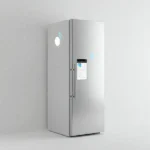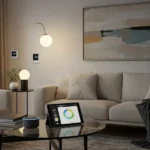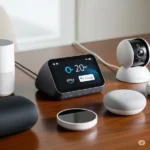Smart Security Systems: Protecting Your Home with AI-Powered Cameras and Locks
In today’s interconnected world, safeguarding our homes has evolved far beyond traditional alarms. Modern smart security systems, powered by Artificial Intelligence (AI), are at the forefront of this transformation, offering a sophisticated and proactive defense that provides unparalleled peace of mind. These advanced solutions seamlessly integrate intelligent detection, enhanced surveillance, and convenient control, redefining what it means to protect your property and loved ones.
The Evolution of Home Security
The global smart home security market is experiencing significant growth, driven by increasing awareness of security concerns, rapid technological advancements, and the desire for greater convenience and control. Consumers are increasingly seeking solutions that offer more than just basic alarms, looking for proactive protection that leverages AI home protection and seamless integration.
AI-Powered Cameras: The Intelligent Eyes of Your Home Security
At the heart of a robust smart security system lie AI security cameras, which move beyond mere recording devices to truly “understand” their visual environment. This cognitive capability allows for highly effective and relevant threat detection, significantly reducing false alarms.
Key Advanced Features and Benefits:
- Facial Recognition Technology: This groundbreaking feature allows cameras to accurately identify individuals based on their unique facial features. Homeowners can create a database of authorized persons (e.g., family, friends, regular service providers). The system can then differentiate between familiar faces and unknown individuals, triggering immediate alerts only when an unrecognized person is detected. This precision drastically minimizes false alarms commonly associated with traditional motion sensors, ensuring you’re only notified of genuine interest.
- Intelligent Package Detection: With the boom in online shopping, package theft has become a prevalent concern. AI cameras are specifically trained to identify packages left at your doorstep, notifying you immediately upon delivery. Crucially, they also alert you if a package is moved or picked up by an unauthorized person, enabling real-time intervention or evidence collection.
- Advanced Object Detection and Classification: Beyond faces and packages, AI algorithms empower cameras to accurately differentiate between humans, vehicles, and animals. This intelligent filtering is crucial for relevant alerts. For example, you can configure your system to ignore your pet’s movements in the yard while still receiving instant notifications if a person enters a specific zone.
- Proactive Behavioral Analysis: More sophisticated AI capabilities allow systems to learn and analyze typical patterns of movement and behavior around your property. Deviations from these norms – such as loitering, unusual nighttime activity, or objects being left behind – can be flagged as suspicious, enabling earlier detection of potential threats.
- Superior Visual Clarity and Night Surveillance: Many contemporary AI cameras boast 2K or even 4K resolution, providing incredibly clear and detailed footage essential for identification. Coupled with advanced night vision technologies (infrared or full-color night vision), they ensure continuous, high-quality surveillance even in low-light or complete darkness.
- Two-Way Audio Communication: This practical feature allows for seamless verbal interaction with individuals at your door or within the camera’s view. Whether you’re instructing a delivery driver, greeting a visitor, or deterring an unwelcome presence, two-way audio adds an active layer of security.
- Secure Cloud Storage and Remote Accessibility: Most reputable smart camera systems offer encrypted cloud storage for recorded footage, ensuring your evidence is safely backed up and accessible from anywhere via a dedicated smartphone application. Remote access also empowers you to view live feeds, arm/disarm your system, and manage settings on the go.
Smart Locks: The Intelligent Gatekeepers to Your Home
Complementing AI-powered cameras, smart locks provide sophisticated access control and significantly enhance the security of your entry points. They offer convenience, flexibility, and robust protection.
Key Features and Advantages:
- Diverse Keyless Entry Options: Say goodbye to fumbling for keys. Smart locks redefine entry convenience by eliminating the need for physical keys. Common methods include:
- Smartphone Control: Lock or unlock your door remotely with a simple tap on your mobile app.
- Numeric Keypads: Utilize customizable PIN codes, allowing you to generate unique and temporary access codes for guests, cleaners, or maintenance personnel, with pre-defined schedules.
- Biometric Authentication: Leveraging fingerprint scanning, and increasingly facial recognition, for highly secure, swift, and convenient access. This is particularly useful for families.
- Proximity Entry (RFID/NFC): Unlock the door by simply tapping a compatible card, fob, or even your smartphone.
- Remote Monitoring and Management: From anywhere with an internet connection, you can check the real-time status of your lock (locked/unlocked), receive alerts when someone enters or exits, and remotely grant or revoke access as needed.
- Granular Access Control: Create and manage multiple user codes with customizable permissions, specifying active days, times, and even one-time use. This is invaluable for managing access for various individuals without sharing physical keys.
- Detailed Activity Logs: Smart locks maintain a comprehensive audit trail, logging every entry and exit, including the user and timestamp. This provides invaluable historical data for security and peace of mind.
- Seamless Smart Home Integration: A significant advantage is the ability to integrate smart locks with your broader smart home ecosystem. For instance, unlocking your front door can automatically disarm the security system, turn on specific lights, or adjust the thermostat, creating a truly automated welcome.
- Enhanced Physical and Digital Security: Reputable smart locks often incorporate built-in alarms that trigger upon tampering or forced entry attempts. They also utilize robust encryption protocols to secure wireless communication, minimizing the risk of cyber vulnerabilities. Many models also include fail-safes like battery backups or traditional key overrides.
Expertise, Authoritativeness, and Trustworthiness (E-A-T) in Smart Home Security
Choosing the right smart security system for your home requires careful consideration and reliable information. To ensure you’re making an informed decision, it’s crucial to consult sources that demonstrate Expertise, Authoritativeness, and Trustworthiness (E-A-T).
- Expertise: Look for information provided by security professionals, certified smart home installers, or technology journalists with a deep understanding of AI, IoT, and cybersecurity. Their insights are invaluable.
- Authoritativeness: Prioritize content from established organizations, reputable industry associations, or well-known tech publications. These entities often have rigorous review processes and contribute to industry standards.
- Trustworthiness: A trustworthy source will be transparent about its information, provide references, and be unbiased in its recommendations. Check for clear contact information, privacy policies, and a history of accurate reporting. Be wary of sources that seem overly promotional or lack detailed explanations.
Frequently Asked Questions (FAQ) About Smart Home Security Systems
Q1: How do AI-powered cameras reduce false alarms? A1: AI cameras use advanced algorithms to differentiate between various objects like humans, animals, and vehicles. This allows them to ignore irrelevant movements (e.g., a pet walking by, tree branches swaying in the wind) and only trigger alerts for events that meet predefined criteria, significantly reducing unnecessary notifications.
Q2: Are smart locks truly secure against hacking? A2: Reputable smart locks use strong encryption (e.g., AES) for communication and implement robust cybersecurity measures. While no system is 100% hack-proof, choosing products from trusted brands, using strong, unique passwords, enabling two-factor authentication, and keeping firmware updated significantly reduces the risk of cyber vulnerabilities. Physical tampering defenses are also integrated.
Q3: Can smart security systems work during a power outage or internet disruption? A3: Many smart security systems, especially professional-grade ones, include battery backups for cameras and control panels. Some devices may also have local storage (SD cards) to continue recording even without internet. Smart locks often have traditional key overrides or can operate on local Bluetooth connections, ensuring functionality during outages. It’s crucial to check the specific features of the system you choose.
Q4: Is professional installation necessary, or can I DIY? A4: Many modern smart security systems are designed for DIY (Do-It-Yourself) installation, particularly for simpler setups. However, for comprehensive systems involving multiple cameras, wired components, or complex integrations, professional installation by a certified technician is often recommended to ensure optimal performance, proper placement, and full system functionality.
Q5: What are the privacy implications of using AI cameras with facial recognition? A5: Facial recognition technology raises privacy concerns. Reputable manufacturers implement features like local processing (where data is analyzed on the device rather than sent to the cloud) and robust data encryption. Users should always review the manufacturer’s privacy policy and understand how their data is collected, stored, and used. Consideration of local privacy laws concerning surveillance in private spaces is also important.
Q6: How do smart security systems integrate with other smart home devices? A6: Most smart security systems are built on common communication protocols like Wi-Fi, Bluetooth, Zigbee, or Z-Wave. This allows them to connect and communicate with other compatible smart devices such as smart lights, thermostats, and voice assistants (like Google Assistant or Amazon Alexa). This integration enables automated routines, such as lights turning on when motion is detected, or the AC adjusting when you unlock your front door.
Additional helpful information
Some information about smart home ecosystems – Smart Home Ecosystems: HomeKit vs. Google Home vs. Alexa
Trusted External Resources for Further Reading:
- National Institute of Standards and Technology (NIST): A leading government agency that provides standards and guidelines for cybersecurity, including smart home devices. Their publications offer in-depth technical insights.
- CNET Home Security Reviews: CNET is a widely recognized technology review site that offers comprehensive, independent reviews and buying guides for smart home security systems and individual components.
- Research Papers on AI in Security: For a deeper technical dive, academic papers often discuss the foundational principles and advancements in AI for security cameras.
- Privacy International: An organization that advocates for privacy rights and often publishes on the implications of surveillance technologies like facial recognition.




